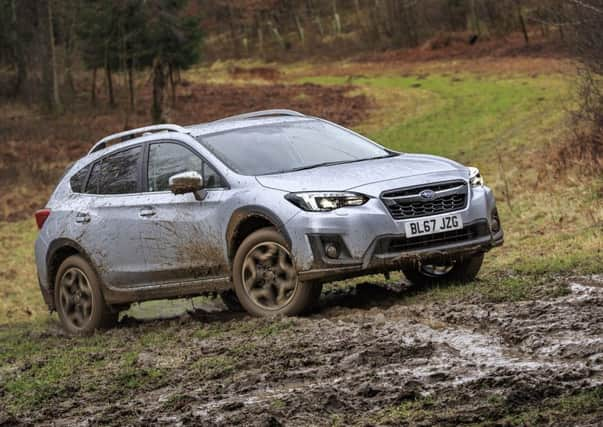Review: Subaru XV Lineartronic


The gist was that it wasn’t a winner. Then I looked at the “mags” to see what they had to say. Hmm, more criticism about the ride quality, the lack of a diesel engine and the lazy performance of the petrol engine, the noise when revved, dissatisfaction with the automatic gearbox, its price and so on.
There was agreement that with Subaru’s permanent (and superior) 4x4 drive system, it was much better off-road than the wave of popular crossovers cum SUVs and similar variants on a five-door hatchback.
Advertisement
Hide AdAdvertisement
Hide AdThere is a good marketing point, of course, that Subaru’s XV is far better suited to a more rugged country life than more modest soft roaders like the Hyundai Kona, Kia Stonic, the various Volkswagens, Seats and Skodas sharing components and aspirations, and the Peugeot, Citroën, Vauxhall camp.
The obverse is that the XV and other Subarus are in a niche so small it’s almost a crack. First quarter sales of just 978 are easily the lowest of any mainstream brand (other than the diving SsangYong) but grew by almost five per cent when the overall market was down more than 12 per cent. Sales performance is none of our business anyway, unless it presages failure – like Saab and Proton.
One catch with the XV is the very limited mechanical choice – a weedy 112bhp petrol 1.6 SE from £24,500 or the 154bhp petrol 2-litre from £26,510. Gearboxes are automatic. What! No diesel? Some of “us” have been hooked on diesel power. It gives higher mileage, more immediate engine response, a better driving experience. It allows company car drivers to barrel along at speed without punitive fuel bills.
The only transmission is the Lineartronic continuously variable automatic which helps ramp up the price, as does the high-value standard specification which brings crash prevention, rear cross-traffic detection, smartphone integration, LED headlamps which follow the steering, high-beam dipping, electronic low-speed traction and hill descent systems and a large touchscreen. Another £2,000 for the SE Premium specification brings navigation, leather seats with power adjustment for the driver, a sunroof and 18-inch wheels.
Subaru is one of the few carmakers dedicated to 4x4 vehicles. Even Land Rover offers some versions without 4x4. The XV ground clearance of almost nine inches (221mm to be exact) is much higher than the wannabe SUVs. The XV is unique in having permanent 4x4 traction through symmetrical drive shafts for optimum progress. (The “others” have front wheel drive with the rear wheels engaging when needed. This reduces fuel consumption.)
Subaru’s other USP in class is a flat “boxer” engine (viz Porsche) which lies flat, like a squashed V4. The reciprocal punching of the cylinders reduces vibration. The flattened mass lowers the centre of gravity and adds traction to the front wheels.
The XV exterior at first glance is similar to the 2012 original but everything has changed and it uses a larger platform which, according to Subaru, is so much better and stiffer that it makes the first XV sounds like a twisting, shaking wreck. In fact, it wasn’t at all useless. I recall a punishing track, quarry and boggy mire event where the XV was as happy and as capable as a pig in muck.
The new XV must be at least as good, but my miles were on public roads this time. I loved it. I liked the fact that it was on proper mixed terrain tyres (Bridgestone’s proven Dueller), worth having even if they did sing a little.
Advertisement
Hide AdAdvertisement
Hide AdThe XV character is willing, eager. The CVT’s response has been critiqued but I am not sure why. Flatten the alloy pedal and the XV feels more powerful than its quoted 154bhp and quicker than the 10.4 seconds time for its 0-62mph sprint. The handling caused no concern and the constant 4x4 grip ensures there is reliable traction on wet corners – if that’s how you drive. Expect some wheel thud over road faults.
The test car was the 2-litre S Premium (£29,060 including a questionable £550 extra for the “pure red” paint). The interior was smart and functional, with push-buttons to back up the touchscreen input. The navigation was easy and accurate. However, the dashboard does not have the clean, integrated style familiar in VW Group cars.
This latest XV has grown, and the width of 58 inches between the doors is better than the class average. There are bottle pockets in all the doors. The rear seats fold flat in seconds for maximum luggage capacity but some rivals offer more space. On the outside all the lower edges are protected by tough black cladding. A glossy black cap hangs over the tailgate for a touch of sportif on an otherwise workmanlike body.
Up top, it’s good to get a useful gap between the roof and the side rails for easier roping and kit attachment.
Verdict: A real all-roader, with character. Just the job.
Stop press: Subaru has also dropped the diesel engine from its 2018 Outback.